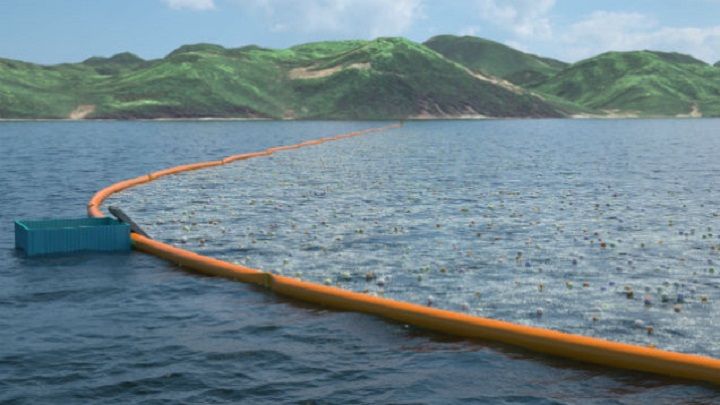
Humanity has a trash problem. Not only do we produce too much of it, far too much ends up in our oceans where it accumulates into "trash islands". Every year, these massive islands of plastics, debris and chemicals - such as the Great Pacific Garbage Patch (GPGP) - play havoc will wildlife, fishing, tourism, and cost billions to cleanup. Worse yet is the fact that these patches consist only of the garbage that we can see.
According to a recent study, roughly eight million tons of plastic trash are deposited into the ocean every year, which is likely to increase tenfold in the coming years. Luckily, a young Dutch inventor named Boyan Slat has come up with an innovative solution that is both cost-effective and self-sustaining. It's known as The Ocean Cleanup, an idea that might just be the most ambitious environmental project in history.
Slat's plan is both simple and elegant. By placing a series of enormous floating barriers (called gyres) in rotating tidal locations where garbage patches exist, an estimated 7,250,000 tons of plastic waste could be removed from the ocean. Rather than relying on trawlers, nets, and time-consuming methods to deal with trash, Slat's idea relies on a process known as "passive collection".

The Ocean Cleanup project relies on self-sufficient booms to remove millions of tons of plastic garbage. Credit: The Ocean Cleanup
Consisting of V-shaped buffers 100 km in length that are anchored by floating booms, these traps have the added bonus of being safe for wildlife. With each buffer, the current flows underneath the booms, allowing sea animals to pass through safely. Meanwhile, the buoyant plastics are pushed along the surface by wind, and then funneled and captured by the buffer.
What's especially innovative about this design is the level of self-sufficiency involved. Besides relying on natural currents, each platform is designed to be powered by 162 solar panels. The technology is also scalable, so booms of varying size can be created based on the size of the garbage patch involved.
As Slat has pointed out, traditional methods are not only expensive and limited, they are also hampered by the fact that they defeat the purpose of environmental cleanup. "Not only would by-catch and emissions likely cancel out the good work," he said, "but also, due to the vastness of areas in which the plastics concentrate, such an operation would cost many billions of dollars, and thousands of years to complete.”
A former aerospace engineering student, Slat came up with the idea for an ocean-cleaning barrier after taking a diving trip in Greece in 2011. While snorkeling in the Mediterranean, he was astounded by the amount of plastics he saw in the water, which was many times more than the number of fish. Upon returning home, he got to work on his concept and began enlisting the help of friends and colleagues.
In 2012, Slat had the opportunity to introduce the idea at a TEDx Talk conference in the Netherland; and since that time, his proposal has received its fair share of accolades. These includes being recently named a finalist in London’s Design Museum's Design of the Year awards. He and his team also began to conduct survey missions and feasibility studies to see where their booms would make the biggest difference.
Last year, the project officially kicked off with a series of successful crowdfunding campaigns that managed to raise over US$ 2 million in just 100 days. And as of last month, Slat announced that his non-profit would be deploying their first ocean-cleaning system in 2016 near the Japanese island of Tsushima, situated in between Japan’s Nagasaki prefecture and South Korea.
Meanwhile, The Ocean Cleanup will be sending 50 vessels to scour the area between Hawaii and California to make the first hi-res map of plastic floating in the Pacific. In the coming years, if all goes according to plan, they will likely be deploying booms to the GPGP, effectively attacking ocean waste at its largest concentration.
Do you have ideas on how we can clean up the planet? Then check out the Operation Methane Harvest Challenge, the TEN9 Challenge, or the Fuel Freedom Fuelx Challenge for a chance to win up to $1 million in prizes!
Top Image Credit: The Ocean Cleanup








